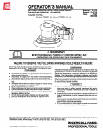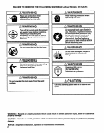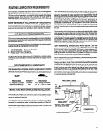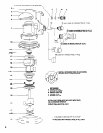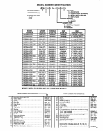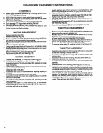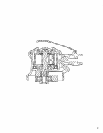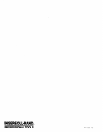
ROUTINE LUBRICATION REQUIREMENTS
Air line debris, moisture and carry-over oil from the compressor
can restrict the muffler and leave contaminants in the motor. Every
160 hours of tool operation, or sooner if motor speeds drop below
accepted speed, flush the tool with a solution of equal parts of
cleaning solvent and spindle oil. Flush the muffler with cleaning
solvent and blow out any trapped debris.
EVERY 160 HOURS OF TOOL OPERATION - Inject grease #68,
one or two strokes, thru threaded end of spindle (27) for lubrica-
tion of needle bearing contained in counterbalance (26). Sanding
pad must be removed from spindle to allow injection of grease.
AIR SUPPLY REQUIREMENTS
This tool has been designed to operate without air line lubrication.
Introduction of a lubricant with a standard filter/regulator/lubricator
will not effect tool life.
For maximum operating efficiency, the following air supply specifi-
cations should be maintained to this air tool:
l
AIR PRESSURE - 90 p.s.i.g. (6.2 bar)
l
AIR FILTRATION - 50 micron
l
HOSE SIZE - 5/16” (8 mm) I.D.
An IR model CO5-02-GOO air line FILTER / REGULATOR / LUBRI-
CATOR is recommended to maintain the above air supply of air to
the tool.
RECOMMENDED LUBRICANTS
After disassembly is complete, all parts, except sealed or shielded
bearings, should be washed with solvent. To relubricate parts, or
for routine lubrication, use the following recommended lubricants:
Where Used
IR Part # Description
‘0” Rings & Lip Seals IR36460 4 OZ. Stringy Lubricant
Gears and Bearings
#68
5 lb. “EP” - NLGI #l Grease
INSPECTION, MAINTENANCE AND INSTALLATION
Disconnect air supply from the tool or shut off air supply and ex-
haust (drain) line of compressed air before performing mainte-
nance or service to the tool.
It is important that the tools be serviced and inspected at regular
intervals for maintaining safe, trouble-free operation of the tool.
Be sure that the air supply lines and connectors are of proper size
to provide a sufficient quantity of air to the tool.
Tool maintenance and repair shall be performed by authorized,
trained, competent personnel. Tools, hose and fittings shall be re-
placed if unsuitable for safe operation and responsibility should
be assigned to be sure that all tools requiring guards or other safe-
ty devices shall be kept in legible condition. Maintenance and re-
pair records should be maintained on all tools, Frequency of
repair and the nature of the repairs can reveal unsafe application,
Scheduled maintenance by competent authorized personnel
should detect any mistreatment or abuse of the tool and worn
parts. Corrective action should be taken before returning the tool
for use.
Disassembly should be done on a clean work bench with a clean
cloth spread to prevent the loss of small parts. After disassembly
is completed, all parts should be thoroughly washed in a clean sol-
vent, blown dry with air and inspected for wear levels, abuse and
contamination. Double sealed or shielded bearings should never
be placed in solvent unless a good method of m-lubricating the
bearing is available. Open bearings may be washed but should
not be allowed to spin while being blown dry.
Upon reassembling, lubricate parts where required. Use #68
grease, or equivalent, in bearings. Use lR36460 lubricant for “0
ring assembly. When assembling “0” rings or parts adjacent “0
rings, care must be exercised to prevent damage to the rubber
sealing surfaces. A small amount of grease will usually hold steel
balls and other small parts in place while assembling.
When replacement parts are necessary, consult drawing contain-
ing the part for identification.
Always use clean, dry air. Dust, corrosive fumes and/or excessive
moisture can damage the motor of an air tool. An air line filter can
greatly increase the life of an air tool. The filter removes rust,
scale, moisture and other debris from the air lines, Low air pres-
sure (less than 90 p.s.i.g.) reduces the speed of the air tool. High
air pressure (more than 90 p.s.i.g.) raises performance beyond
the rated capacity of the tool and could cause injury. Shown below
is a typical piping arrangement.
MAIN LINES 3 TIMES
AIR TOOL INLET SIZE
3



